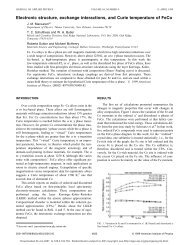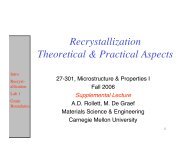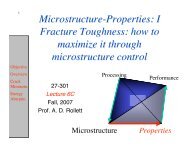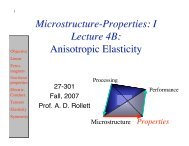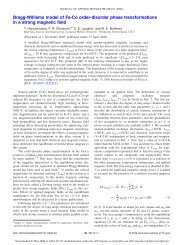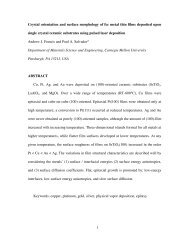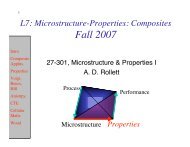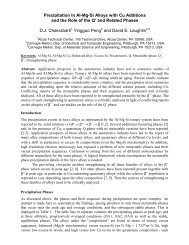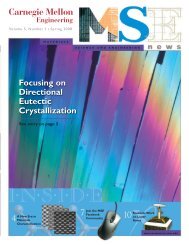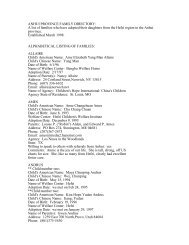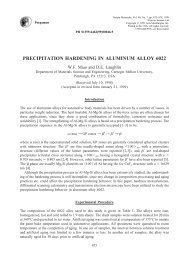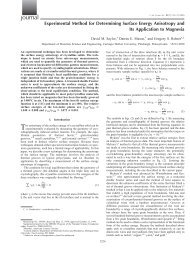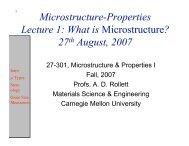CMU News (Page 2) - Materials Science and Engineering ...
CMU News (Page 2) - Materials Science and Engineering ...
CMU News (Page 2) - Materials Science and Engineering ...
You also want an ePaper? Increase the reach of your titles
YUMPU automatically turns print PDFs into web optimized ePapers that Google loves.
cover story<br />
MSE Undergraduate Studies Photochemical<br />
Properties of TiO 2 Surfaces<br />
Photochemical processes at TiO2 surfaces have been studied because of their<br />
importance for the conversion of solar energy, as well as their role in the performance<br />
of self-cleaning coatings. Of particular interest is the photocatalyzed synthesis of hydrogen<br />
fuel from sunlight <strong>and</strong> water (photolysis). If the efficiency of water photolysis by<br />
TiO2 can be increased <strong>and</strong> the cost reduced, it may provide a renewable source of<br />
hydrogen fuel. With this goal in mind, students in the Department of <strong>Materials</strong> <strong>Science</strong><br />
<strong>and</strong> <strong>Engineering</strong> are conducting research aimed at underst<strong>and</strong>ing the relationship<br />
between surface structure <strong>and</strong> the efficiency of photochemical reactions. The atomic<br />
force microscopy image on the cover was made by Lizza D. McGregor, Class of<br />
2007. The image shows platy crystals of hydrocerrusite, Pb3(CO3)2OH, formed<br />
during the photochemical oxidation of Pb(II) on the TiO2 surface. Although the<br />
hydrocerrusite is a “spectator” phase that is not central to the photochemical process,<br />
it is highly photogenic.<br />
faculty update<br />
Whitacre Joins<br />
MSE Faculty<br />
Jay Whitacre<br />
joined the Carnegie<br />
Mellon University<br />
faculty in September<br />
as an Assistant<br />
Professor in the<br />
Department of<br />
<strong>Materials</strong> <strong>Science</strong><br />
<strong>and</strong> <strong>Engineering</strong> <strong>and</strong> the Department of<br />
<strong>Engineering</strong> <strong>and</strong> Public Policy.<br />
Whitacre received his B.A. from<br />
Oberlin College in 1994, where he<br />
graduated with honors in Physics. He<br />
then earned his Masters (1997) <strong>and</strong> Ph.D.<br />
(1999) degrees in <strong>Materials</strong> <strong>Science</strong> from<br />
the University of Michigan, Ann Arbor.<br />
Whitacre was a Postdoctoral Scholar<br />
at the California Institute of Technology<br />
from 1999 to 2000. He subsequently<br />
became a Senior Member of the Technical<br />
Staff at the Jet Propulsion Laboratory<br />
(JPL) in Pasadena, California. His work<br />
there focused on synthesizing, characterizing,<br />
<strong>and</strong> implementing nanostructured<br />
materials for electrochemical devices<br />
such as Li-ion batteries <strong>and</strong> fuel cells. His<br />
other research topics included investigations<br />
of solid-state integrated hybrid<br />
energy collection <strong>and</strong> storage devices,<br />
high throughput materials selection<br />
methods, <strong>and</strong> conformal polymeric<br />
coatings for interplanetary space probes.<br />
Starting in 2004, Whitacre was trained<br />
as a Power Systems Engineer by the JPL<br />
systems design group. He subsequently<br />
became a member of “Team X,” a concurrent<br />
engineering design group focused on<br />
developing next-generation spacecraft.<br />
Whitacre’s charter in the Department<br />
of <strong>Materials</strong> <strong>Science</strong> <strong>and</strong> <strong>Engineering</strong> is to<br />
conduct research on materials for energy<br />
systems, while also considering the policy<br />
implications involved in selecting <strong>and</strong><br />
implementing the next generation of<br />
renewable energy technologies. His<br />
initial work will be focused on large<br />
format Li-ion batteries <strong>and</strong> novel PEM<br />
fuel cell catalyst materials <strong>and</strong> structures.<br />
Whitacre has received several awards<br />
in his career, including the MRS Graduate<br />
Research Award, Fall 1998 (silver medal);<br />
the 1999 University of Michigan<br />
Departmental Graduate Student Research<br />
Award; the 1999 American Vacuum Society<br />
Graduate Research Award (Thin Films<br />
Division); the 2001 Norman Hackerman<br />
Young Author Award (Electrochemical<br />
Society); <strong>and</strong> multiple JPL <strong>and</strong> NASA<br />
Space Act R&D Awards from 2002 to 2006.<br />
3



